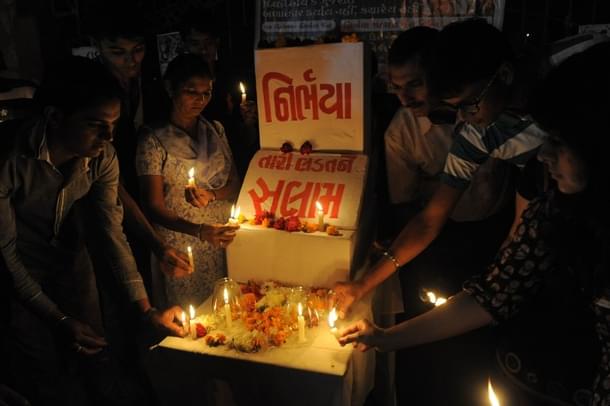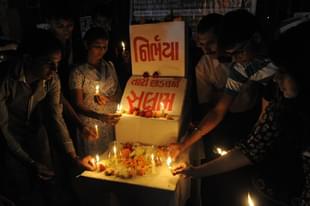Culture
India’s Daughter: An Indian Daughter’s Opinion
Beloo Mehra
Mar 05, 2015, 07:23 PM | Updated Feb 11, 2016, 08:39 AM IST
Save & read from anywhere!
Bookmark stories for easy access on any device or the Swarajya app.


The solutions for issues of women’s security in India can only be found at a more profound level, one that goes deeper and beyond than instantaneous outrage
1927 – Katherine Mayo writes a book and titles it “Mother India.” Mahatma Gandhi termed it as a “drain inspector’s report.”
2015 – BBC produces a documentary on one of the worst rapes perpetrated in recent Indian history, and titles it “India’s Daughter,” to be telecast on International Women’s Day. I wonder what the Mahatma would say to that.
Can you imagine if an Indian film-maker were to make a documentary on the thousands of cases of sexual abuse and “grooming” of young girls in Rotterham between 1997-2013, and title it “Britain’s Daughter”?
No, I can’t imagine it ever happening like that. And that’s where the difference lies.
The difference lies between an approach which only ends up sensationalising and an approach which ends up educating; between alternative views on how a grievous and world-wide social problem like rape and violence toward women should be addressed. How societies, and particularly the youth and children, should be sensitized and made aware of this global menace of unspeakable cruelty toward women and girls.
I haven’t seen the film, obviously. And after reading some snippets of the interview with the death-row convict of December 16, 2012 brutal rape in Delhi, I am not even sure I would like to watch the film. I have read that the film also includes interview with the parents of Nirbhaya, a brave woman who valiantly fought till the end. I have also read that the film speaks about the massive protests that happened in the aftermath of the atrocious crime, indicating a mass awakening among the Indian youth and general populace. [It is a different matter whether such awakenings that are led more by momentary passion than a serious study of the problem can ever lead to any positive results, but we can let that pass for the moment.]
Yet I am not sure I will watch the film.
Before I proceed further, let me also add that in my opinion, the call for banning the film is not the answer. Banning is never the answer. But first we also need to know the questions that we need to ask.
We need to ask that in the asymmetrical power structure of the present-day discourse on gender violence, how a media source like BBC can get the permission to interview the death-row convict in prison for 16 hours. We need to ask whether the people in-charge of giving such permissions are even aware of the asymmetrical nature of discourse in the global media.
But for the moment we can even let such questions pass. Because there are even more serious questions that demand our attention.
And these regarding why such horrible atrocities against women happen in the first place, in India and elsewhere. There are many questions regarding why some cases of violence against women are highlighted by media while thousand others don’t even get a mention anywhere.
There are many questions regarding why some sections of the widely-read Western media are so obsessed with reporting and analysing rapes in India while often conveniently ignoring similarly grievous nature of the problem in their own backyards.
There are questions regarding the psychological and sociological factors that may help us understand the criminal behaviour in order to seriously investigate the possibility of any remedial actions. There are also questions regarding whether law enforcement system – anywhere in the world – can incorporate any serious reform or remediation of the psychology of the criminal.
Does the film seriously address any of these questions? I don’t know.
What I do know at present is that the film includes an interview with one of the perpetrators of the December 16, 2012 rape. And this death-row convict spews his extreme hatred of women. He may be speaking only for himself. And it is also very likely that he may not be alone in having such atrocious, vicious, hate-filled opinions.
But you and I both know that such horrible filth is always to be found in the gutters. What do you expect to find when you look inside a gutter? Certainly not any light.
Criminal psychology is a serious field of study, to be practiced by well-trained experts with deep sensitivity and awareness of sociological-psychological pathologies. Journalistic investigations cannot be a substitute for serious research. And certainly sensational reporting is never the solution to anything, other than being only a means to stir up the emotions of gullible audience for perhaps just a few minutes of their otherwise busy lives full of personal ambitions and agendas.
What do films like “India’s Daughter” end up achieving?
In my opinion, films like these end up giving fodder to susceptible sections of the social elite, especially the most radicalized, vital-sensationalist minds, to mindlessly start generalizing about a whole society and culture on the basis of the most vile, vicious thought uttered by someone like the convict who was interviewed for this film.
Already I have seen more than enough of status updates on Facebook about how misogynist the whole of Indian society is, how horrible the attitudes of Indian men are, how women are abused left and right in India, etc. etc. And I am not on Twitter, which I am sure will be even worse. And of course, then there is our mainstream media which I am sure will be giving undue and unnecessary publicity to this whole thing.
We all know one evil-minded convict’s opinion about attitudes toward women should not and cannot say anything about a huge society like India. And yet, that’s how the dice roll in the sensationalism-loving, TRP-obsessed, media-crazy world of today. The end result is that more young and impressionable minds get alienated from their cultural/societal roots because they are most susceptible to the media-constructed realities of what their society is like. This is most unfortunate, really.
Things are never as simple as they seem on the surface. Just as I wouldn’t generalize anything about Indian mindsets or attitudes based on a few random observations or experiences, I also wouldn’t generalize about all India-related reporting that happens in the Western media. There is a huge diversity of mindsets and attitudes, everywhere.
But there certainly is a noticeable trend in the Western media reporting, especially about the issues and challenges facing Indian society and culture. Most of the reporting focuses on the negatives and the extremes. No serious effort is made to put things in a balanced perspective and well-intentioned context. Rather the tendency is to highlight the bizarre and zoom in on the most atrocious resulting in mere sensationalising of the issue under investigation.
It is this tendency that makes me wary of such films like “India’s Daughter.”
The real cause of any sociological problem always lies in the depths of our grossly imperfect human nature. There are some common human frailties and weaknesses, for example, tendency to assert power, anger, extreme frustration, deep inner violence which leads to violence outside, all of which are to be found all over the human race, East or West. It is such tendencies that manifest in violence toward women and children.
What can be done to address this core problem? That, as they say, is the million-dollar question. The answer to this cannot be found in mass protests or angry reactions to what one convict and his lawyers say. The answer to this can certainly not be found by looking into the gutter.
The answer may be found when we begin to highlight and learn from the stories of those daughters of India who have shown the path of courage and self-respect to countless other women. The answer may be found when we begin to highlight and learn from the stories of those countless sons of India who have worked shoulder to shoulder with women fighting for their safety and self-respect.
The answer may be found when we, each one of us, begin to walk away from mere sensationalism and endeavour a serious study of the root cause of the problem. This may require each one of us to make a serious effort toward understanding our own frailties and weaknesses, our own prejudicial attitudes and biased mental structures, our own conditioning of minds and our own processes of de-conditioning.
I go back to what I said at the beginning of this piece. In my opinion, the reason why an Indian film-maker would probably never consider making a film titled “Britain’s daughter” is not simply because of the asymmetry of the power structure of global media and discourse. It is primarily because the Indian cultural approach to sociological problem solving emphasises a more inward looking approach. We may be consciously aware of this truth or not, but our millennia-old culture surely points us to this truth. The truth that unless we each clean up our own house, we can’t clean up the society. Criminal justice system, law enforcement and policing can only be aids, never the real solution.
Beloo Mehra is an educator, with many years of teaching and research experience in social sciences, in India as well as in the US. She is the author of a newly released book, ABC's of Indian National Education, and regularly writes a blog inspired by her study of the works of Sri Aurobindo.





